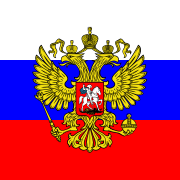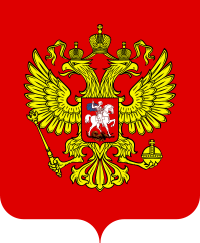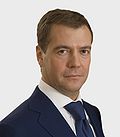President of Russia
| President of the Russian Federation |
|
 Official Standard |
|
| Appointer | Direct popular vote |
|---|---|
| Term length | Six years, renewable once, consecutively |
| Inaugural holder | CPD of RSFSR (4 April 1991)[1] |
| Formation | 10 July 1991 |
| Website | (Russian) kremlin.ru/ (English) kremlin.ru/eng/ |
| Russia |
 This article is part of the series: |
|
|
|
|
Other countries · Atlas |
The President of Russia (Russian: Президент России) or the President of the Russian Federation, Russian: Президент Российской Федерации) (before 25 December 1991: President of the Russian Soviet Federative Socialist Republic Russian: Президент Российской Советской Федеративной Социалистической Республики) is the Head of State, Supreme Commander-in-Chief and highest office within the Government of Russia. Executive power is split between the President and the Prime Minister, who is the Head of Government.
Contents |
History of office
The office was instituted as the President of the RSFSR by the third Special Congress of People's Deputies of RSFSR on 4 April 1991[1]. This was only possible following the reforms of the Soviet leader Mikhail Gorbachev who had become first and only President of the Soviet Union one year earlier, on 15 March 1990. The respective revisions in the Constitution of the RSFSR (accepted in 1978) were introduced on 24 May 1991[2]. The same law also introduced the office of Vice-president of the RSFSR. According to the 1991 law the President and the Vice-president were to be elected together by a direct popular vote for a five-year term.
The only President and Vice-President of the RSFSR were Boris Yeltsin and Aleksandr Rutskoy. They were elected on 12 June 1991 and came into power on 10 July. On 25 December 1991 with the reorganization of the RSFSR into an independent Russian Federation they became the first President and Vice-President of the Russian Federation.
During the Russian constitutional crisis of 1993 Vice-president Rutskoy was acting "in opposition" and from 22 September 1993 until 4 October 1993 had proclaimed himself as President. The new (and current) Constitution of the Russian Federation (accepted in 1993 after the crisis) no longer includes the office of Vice-president and reduces the presidential term to four years.[3]
Yeltsin was re-elected for a second term in the second ballot on 3 July 1996 (the first ballot was on 16 June) and inaugurated on 9 August. Yeltsin resigned from the office on 31 December 1999 putting Prime Minister Vladimir Putin as acting president.
The second President of Russia was Vladimir Putin – he was elected for a first term on 26 March 2000 (inaugurated on 7 May) and re-elected for a second term on 14 March 2004 (inaugurated on 7 May).
The third and current President of Russia is Dmitry Medvedev – he was elected on 2 March 2008 and inaugurated on 7 May.
The term length was extended to six years in late 2008.
Requirements to hold office
According to the Constitution of the Russian Federation, a person willing to run for presidency has to be a citizen of Russia not younger than 35, who has permanently resided in the Russian Federation for not less than 10 years.
The Constitution of Russia also restricts the period during which a person can hold the office of the President to two consecutive terms. There is no limit to total terms that a President may be served, just a limit on successive terms.
Rights and duties
- The President is the guarantor of the Constitution of Russia and of human and civil rights and freedoms. In accordance with the Constitution, he (she) adopts measures to protect the sovereignty of Russia, its independence and state integrity, and ensures the coordinated functioning and interaction of State government bodies.
- The President determines the basic objectives of the internal and foreign policy of the State.
- as the Head of State, represents Russia within the country and in international relations.
- appoints, with the consent of the State Duma, the Chairman of the Government of the Russian Federation;
- has the right to chair meetings of the Government of Russia;
- adopts decisions on the resignation of the Government of the Russian Federation;
- nominates a candidate for appointment to the post of Chairman of the Central Bank; raises before the State Duma the issue of relieving the Chairman of the Central Bank of his post;
- in accordance with proposals of the Chairman of the Government of the Russian Federation, appoints and dismisses deputy chairmen of the Government of the Russian Federation and federal ministers;
- presents to the Council of Federation candidates for the posts of judges of the Constitutional Court, the Supreme Court, the Supreme Arbitration Court, and a candidate for the post of the Prosecutor General; submits to the Council of Federation proposals to dismiss the Prosecutor General; and appoints judges of other federal courts;
- forms and heads the Security Council of the Russian Federation;
- approves the military doctrine of the Russian Federation;
- forms the Administration of the President;
- appoints and dismisses representatives of the President;
- appoints and dismisses supreme commanders of the Armed Forces;
- appoints and recalls after consultations with appropriate committees and commissions of the chambers of the Federal Assembly diplomatic representatives of the Russian Federation in foreign States and international organisations;
- announces elections to the State Duma in accordance with the Constitution of the Russian Federation and federal law;
- dissolves the State Duma in the cases and in accordance with the procedure provided for by the Constitution of the Russian Federation;
- announces referendums in accordance with the procedure established by federal constitutional law;
- submits draft laws to the State Duma;
- signs and promulgates federal laws;
- addresses the Federal Assembly with annual messages on the situation in the country and on the basic objectives of the internal and foreign policy of the State;
- may use conciliatory procedures to resolve disputes between State government bodies of the Russian Federation and State government bodies of constituent entities of the Russian Federation, and disputes between State government bodies of constituent entities of the Russian Federation. In the event that no agreed decision is reached, he (she) shall have the right to refer the dispute to the appropriate court;
- has the right to suspend acts of executive government bodies of constituent entities of the Russian Federation in the event that these acts conflict with the Constitution of the Russian Federation and federal laws or with international commitments of the Russian Federation, or violate human and civil rights and freedoms until the issue is resolved by an appropriate court;
- directs the foreign policy of the Russian Federation;
- holds negotiations and sign international treaties;
- signs instruments of ratification;
- receives letters of credence and letters of recall of diplomatic representatives accredited to his (her) office;
- in the event of aggression against the Russian Federation or of an imminent threat of aggression, the President enacts martial law on the territory of the Russian Federation or on certain parts thereof and shall immediately inform the Council of Federation and the State Duma of this;
- decides on issues of citizenship of the Russian Federation and of granting political asylum;
- bestows State awards of the Russian Federation and confers honorary titles of the Russian Federation and supreme military and supreme specialtitles;
- shall grant pardon;
- issue edicts and regulations, which are legally binding on the entire territory of the Russian Federation (however, edicts and regulations of the President must not conflict with the Constitution of the Russian Federation and federal laws.
The president's rights and duties are defined in the chapter 4 of the Constitution.[3]
Insignia
After the oath of office has been taken by the elected president, these following insignia are handed over to the president. These devices are used to display the rank of his office and are used on special occasions.
Chain of office

The first insignia that is issued is the chain of office with an emblem. The central emblem is a red cross, with arms in equal size, charged with the Russian coat of arms. On the reverse of the cross, the words "Benefit, Honor and Glory" (Russian: «Польза, честь и слава»; "Pol’za, chest’ i slava") appear in a form of a circle. A golden wreath is used to connect the cross with the rest of the chain. There are seventeen "links" in the emblem, with nine consisting of the Russian coat of arms. The other eight consist of a rosette, also bearing the motto "Benefit, Honor and Glory." At the inauguration of Vladimir Putin, the emblem was placed on a red pillow, positioned on the left side of podium. According to the Presidential website, the emblem is placed inside the Kremlin and is used only on certain occasions.
Standard (Flag)

The standard is a square version of the Russian flag, charged in the center with the Russian coat of arms. Golden fringe is added to the standard. Copies of the standard are used inside his office, at the Kremlin, other state agencies, and while the president is traveling in a vehicle inside Russia. A 2:3 ratio version of the flag is used when the President is at sea. This is the mostly used symbol to denote the presence of the Russian President.
Special Copy of the Constitution

The President also has a special copy of the Russian Constitution that is used during the inauguration. This copy has a hard, red cover with gold lettering. An image of the Russian coat of arms appears in silver. The special copy is kept in the Presidential Library, which is located inside the Kremlin.
Legal Basis of the Insignia
These insignia and the procedure were established by the presidential decree No. 1138 from 5 August 1996.[4] and modified by decree No. 832 from 6 May 2000.[5] In the new decree the special copy of the Constitution was removed as the third symbol of the Russian Presidency; the other two symbols remained intact because they were and are regulated by separate decrees. Nonetheless, the special copy of the Constitution still exists and serves for inauguration purposes only without being officially presented as a symbol of the Russian Presidency.
Oath of Office
Each person who has been elected to this office takes this oath during their inauguration:
| “ | I do solemnly swear, in the performance of my powers as the President of the Russian Federation, to respect and protect the rights and freedoms of man and citizen, to observe and protect the Constitution of the Russian Federation, to protect the sovereignty and independence, security and integrity of the state and to serve the people faithfully.[6] | ” |
Residences
The primary working President's residence is the Senate building (also known as 1st building) in the Moscow Kremlin complex[7]. Also the President can use the Great Kremlin Palace (the ceremonial residence) and so called 14th building[7] (the reserve residence).
The current (since 2000) home President's residence is Novo-Ogaryovo (Russian: Ново-Огарёво). It is planned that it will have remained at the disposal of Putin after the term ending, as Gorki-9 (Russian: Горки-9) (also called Barvikha (Russian: Барвиха), but actually near it) had remained at the disposal of Boris Yeltsin after his retirement.
Also, the President has several vacation residences outside of Moscow[8].
- Rus (Russian: Русь), Zavidovo, Tver Oblast
- Congress Palace or Constantine Palace complex (Russian: Дворец конгрессов, Константиновский дворец), Strelna, Leningrad Oblast, reconstructed for 300th Saint-Petersburg anniversary
- Bocharov Ruchey (Russian: Боча́ров Руче́й), Sochi
- Shuyskaya Chupa (Russian: Шу́йская Чупа́) at a distance of 25 km from Petrozavodsk, Karelia
- Uzhin (Russian: Ужи́н) at a distance of 20 km from Valday, Novgorod Oblast
- Volzhskiy Utyos sanatorium (Russian: Во́лжский утёс) on Kuybyshev Reservoir shore
- Tantal tourist centre (Russian: Танта́л, lit. Tantalum) on Volga bank, at a distance of 25 km from Saratov
- Sosny (Russian: Со́сны, lit. pines) on Yenisei bank, near Krasnoyarsk
- Angarskie hutora (Russian: Анга́рские хутора́) at a distance of 47 km from Irkutsk
- Maly istok (Russian: Ма́лый исто́к) inside Ekaterineburg forestry
Political affiliation
Though technically the President of Russia may be a member of a political party, traditionally the President is nonpartisan and without political affiliation. He does support a specific party during parliamentary elections in order to promote his agendas and goals. He tends to be above the political spectrum and to act as a statesman, who reconciles and balances between the various political groups while not identifying with any one of them particularly.
Transport
The land transport services for the Russian President is provided by the Special Purpose Garage (SPG)[9]. The SPG is a unit within the Federal Protective Service.
- Limousines
- ZiL
- Mercedes-Benz
- Escort cars
- Mercedes-Benz (including G-Wagens)
- Chevrolet
- Honorary escort (motorcycles)
- Ural
- BMW

The avia transport services for the President is provided by airline company Rossiya[10].
- Airplanes Long distance flight
- Ilyushin Il-96-300PU (long-range) - main President's aircraft
- Ilyushin Il-62M (long-range)
- Tupolev Tu-154 (medium-range)
- Yakovlev Yak-40 (short-range)
- Helicopters
- Mil Mi-8
The President's aircraft use the same color scheme as standard Rossiya aircraft, except for the use of the Russian coat of arms or the Presidential Standard on the empennage instead flag of Russia.
Living former presidents
- Vladimir Putin (born 7 October 1952)
See also
- List of presidents of the Russian Federation
- Russian presidential administration
- List of leaders of Russia
References
- ↑ 1.0 1.1 Gorbachev's Foundation. Chronicles of Perestroika. 1991
- ↑ Law of the RSFSR of May 24, 1991 "On revisions additions of the Constitution of RSFSR"
- ↑ 3.0 3.1 Constitution of the Russian Federation. Chapter 4
- ↑ Coбpaниe зaкoнoдaтeльcтвa Рoccийcкoй Фeдepaции 1996, No. 33, ar. 3976
- ↑ Coбpaниe зaкoнoдaтeльcтвa Рoccийcкoй Фeдepaции 2000, No. 19, ar. 2068
- ↑ Constitution of the Russian Federation, Article 82
- ↑ 7.0 7.1 The Presidential Residences (English)
- ↑ Vladimir Putin Residences // Kommersant, #18(3594), Feb.07 2007
- ↑ President's transports. Cars (Russian)
- ↑ President's transports. Air transport (Russian)
External links
|
|||||||||||||
|
||||||||||||||||||||||||||||||||||||||||||||||||||||||||||||||
|
||||||||
